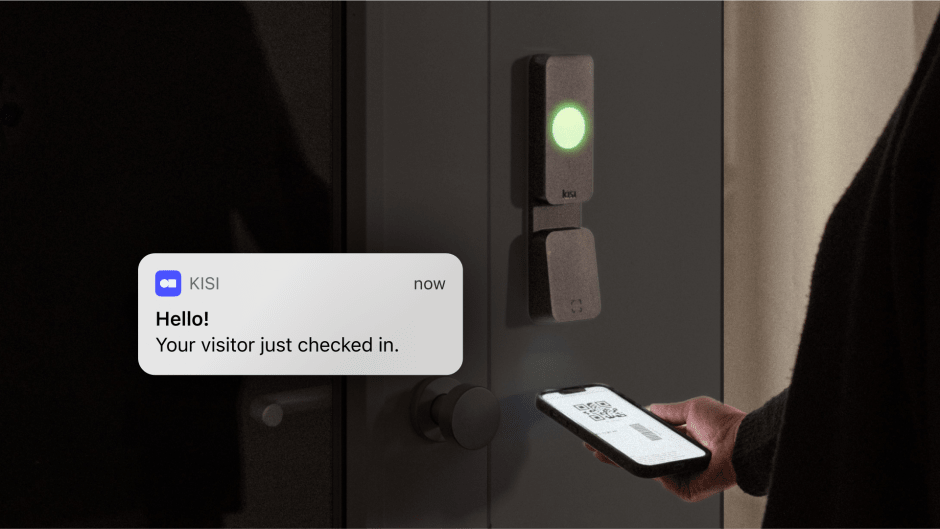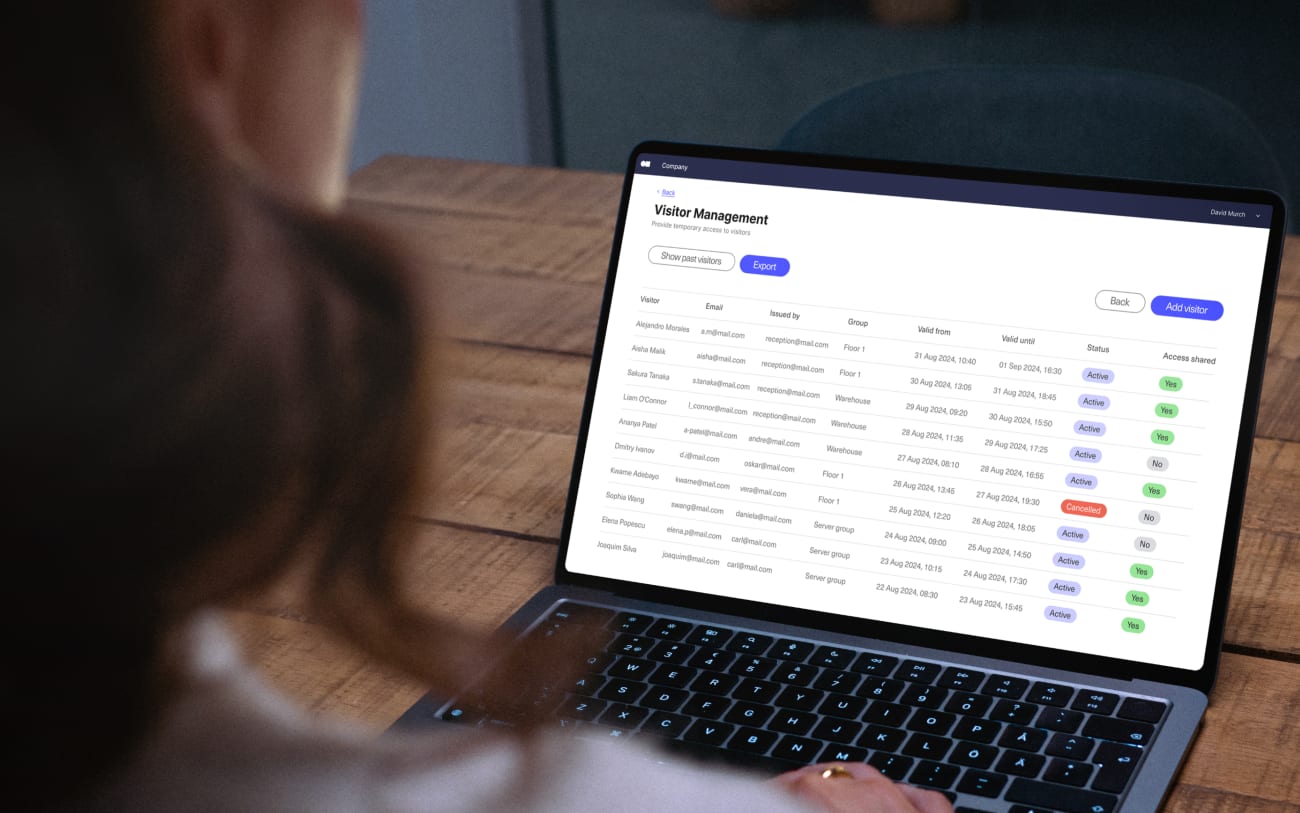A visitor sign-in system solves an ongoing problem: Tracking who enters a business or other facility. However, modern digital visitor management solutions go beyond basic tracking, allowing for more complex activities, such as data analysis, badge printing, and identification (ID) verification. This guide explains how visitor sign-in systems work, what value they offer, and how to select one.
What are visitor sign-in systems? #
Visitor sign-in systems allow you to track and manage people visiting your building or property. They’re not a new concept—people have long used sign-in sheets for record-keeping—but developments in technology have resulted in different, more advanced solutions.

Types #
Visitor sign-in systems are available in paper-based and digital forms. Paper logbooks or sign-in sheets are usually basic documents with a space for visitors to write down their names, contact details, and arrival and departure times. Organizations using this type of sign-in system can store physical copies of the logs and refer to them to verify information in the future.
Organizations opting for digital sign-in systems can choose between standalone apps and full software platforms. Designed for smartphones and tablets, apps are easy to use and require minimal training. Visitors can install an organization’s app on their device and use it to enter their contact information and sign in when they arrive. However, apps that aren’t connected to a more comprehensive software platform usually lack advanced features and are less scalable.
Full visitor sign-in software platforms have the same capabilities as apps but with additional features, such as advanced reporting and integrations with other systems. They’re usually scalable and customizable, and most are cloud-based. This allows for remote visitor management and off-site registration processes.

Purpose #
Visitor sign-in systems are useful to a wide range of organizations. They’re commonly found in businesses, office buildings, warehouses, schools, and healthcare facilities. Regardless of the type of property, a visitor management system typically has the same primary goals:
- Track visitors: First and foremost, a sign-in system provides up-to-date information about who has entered the property or building.
- Improve security: Knowing who is on-site allows organizations to better protect their people and property, and sign-in logs can serve as valuable evidence in the event of a security incident.
- Enhance emergency response: A sign-in system is also critical in an emergency, such as a fire or natural disaster, because it allows an organization to confirm whether everyone who was on site has safely been evacuated from the property.
- Maintain compliance: Many industries, particularly high-risk fields such as finance and healthcare, require strict control of who enters and exits a facility, and a sign-in system allows organizations to meet those standards.
Some sign-in systems achieve these goals more effectively than others. For example, a full software platform offers more in-depth data storage and analytics, which better supports compliance needs.
Key aspects of visitor sign-in systems #
Visitor sign-in systems vary in complexity and design, but they’re usually built on a similar foundation of software and hardware. Implementing a digital system is significantly different from using paper-based sign-in sheets.
Core components #
Manual visitor sign-in systems require very few materials. In most cases, they consist only of a paper logbook or sheet. Digital systems are more advanced and thus require a more technical setup.
Most digital systems involve three essential elements. The first is software, which collects, stores, and processes visitor information. It also allows management, including running reports, viewing data, and modifying visitor permissions.
Digital visitor sign-in systems also generally have an app, which employees and visitors can download to their mobile devices. The app is used for every aspect of the visitor entry process, including pre-registration, sign in, and monitoring. Apps are available both as standalone systems and in conjunction with a full software platform.
Finally, many sign-in systems include hardware. Most prominently, they require a touchscreen device, potentially installed as a visitor kiosk. Printers are also vital for organizations that want to generate badges for visitors to wear while on the premises.
Some systems have optional add-ons, such as cameras to capture photos for printing on visitor badges. If a visitor sign-in system is integrated with access control, it may have additional hardware, such as an access controller, credential reader, and electric locks.

Important features #
This combination of software and hardware enables several crucial features for your sign-in system. They include:
- Pre-registration: To streamline entries and avoid crowding, visitors can enter their information using a mobile visitor sign-in app or software platform before arriving at the property.
- Contactless check-in: Organizations that prefer contactless check-ins for health and safety reasons can allow visitors to sign in with an app on their personal devices rather than touching a shared sign-in log or kiosk.
- Visitor identification: Some systems can scan IDs to ensure visitors don’t have a history of suspicious activity on the premises and aren’t on any lists of potentially dangerous individuals, such as sex offender registries.
- Notifications: Sign-in systems can instantly notify receptionists, managers, and team members when a visitor arrives, decreasing wait times and fostering a more welcoming environment.
- Badge printing: Instead of issuing generic badges, a digital sign-in system can produce a custom badge for each visitor, complete with their name and photo, if desired.
- Integration with access control: Many digital sign-in systems are compatible with access control, allowing organizations to better manage both employee and visitor entries and exits.
Keep in mind that most, if not all, of these features are unique to digital visitor sign-in solutions. Paper-based systems, while useful to certain organizations, are much more limited in their applications.
Comparing digital and manual sign-in systems #
Some small and medium-sized organizations still use manual logbooks, but they have largely fallen out of favor. While they’re undeniably simple, paper-based systems are severely lacking in several areas, particularly when compared to digital options.
Security #
A paper sign-in sheet meets the most basic requirements of visitor management by requiring individuals to check in before entering, but its support for organizational security ends there. A digital system enables real-time tracking that isn’t possible with a manual solution. An organization will always know who is on-site and can easily take steps to verify their identities.
In addition to boosting internal security, a digital system is also more beneficial for visitors because it helps protect their privacy. When using paper sign-in sheets, a subsequent visitor can look at another visitor’s name and contact information. A digital system keeps this information hidden from everyone except for the visitor and the organization.
Compliance #
Manual sign-in systems capture critical information about visitors, but they do very little to improve an organization’s compliance. They can be lost or damaged, and sorting through paper records to provide information during an audit is labor intensive.
Digital systems are more compatible with audits because organizations can generate any reports required by regulatory bodies. These systems automatically log all visitor activity, including time-stamps and contact details, providing more complete records than manual systems.
Another strength of a digital system is its ability to support internal policies and requirements. For instance, an organization can prompt visitors to sign a nondisclosure agreement before entering the premises.
Operations and efficiency #
Manual visitor sign-in systems are inefficient and prone to errors, particularly in comparison to digital options. For instance, if a visitor’s handwriting is difficult to decipher, an employee might waste significant time trying to confirm who is on the property. They might also misunderstand the individual’s name, potentially providing inaccurate information to administrators, security teams, and law enforcement.
Paper-based systems also require someone to manually check each visitor’s identification against a database of authorized individuals. Digital systems, on the other hand, can automatically scan IDs, such as driver’s licenses, and compare their information with criminal records and other information sources.

Cost #
Paper sign-in sheets might initially seem like the less expensive option, but they come with several potential costs that can ultimately exceed a digital system. For example, manual logbooks often require constant oversight by a receptionist or security personnel, which means the organization must factor their salary into the overall expense. Storing paper-based logs is also cumbersome and potentially expensive, particularly if an organization needs to secure several years’ worth of documents for compliance reasons.
Digital visitor sign-in systems have a higher upfront cost, but they eliminate many of the ongoing expenses associated with paper sign-in sheets. Visitors can use these systems independently without support from an employee, so constant coverage is unnecessary. In addition, a digital system doesn’t require extensive physical space because the sign-in data is stored in the cloud or on a local server.
Some digital platforms, like Kisi, offer different tiered plans based on your visitor management needs. If you’re still using manual check-in systems, consider switching to the basic plan, where you can digitally sign in visitors for free.
How to choose a visitor sign-in system for your organization #
When selecting a visitor sign-in system, begin by outlining your needs. Think carefully about the size of your organization and whether a particular system allows for growth and increased visitor volume. In addition, prioritize the features that will best support your organizational structure and security concerns. For example, school visitor management systems typically need to include identification screening and photo capture capabilities to ensure the safety of students and staff.
These points can guide your research into potential sign-in solutions. Visitor management is available from an array of providers, but some have more robust features and more user-friendly designs. The best options available on the market today include:
- Kisi: Kisi’s visitor management features an intuitive dashboard with easy, automated check-ins, and you can combine it with access control and video surveillance using the One Security Platform.
- Archie: Archie is customizable, enabling organizations to allow sign-ins through their branded apps, and also includes desk and room booking.
- Envoy: Well-suited to enterprise companies, Envoy enables custom criteria for entry and screening, as well as desk and room booking features.
- Office RnD: Designed for coworking and workplace management, OfficeRnD allows pre-registration, document signing, and instant notifications.
Check out our list of the best visitor management software for a more detailed comparison of these and other solutions. You can also try out Kisi’s visitor management platform for free, take full advantage of the free plan, or reach out to the Kisi team to learn more about how visitor sign-in and access control systems can work together to enhance your organization’s security and operations.


